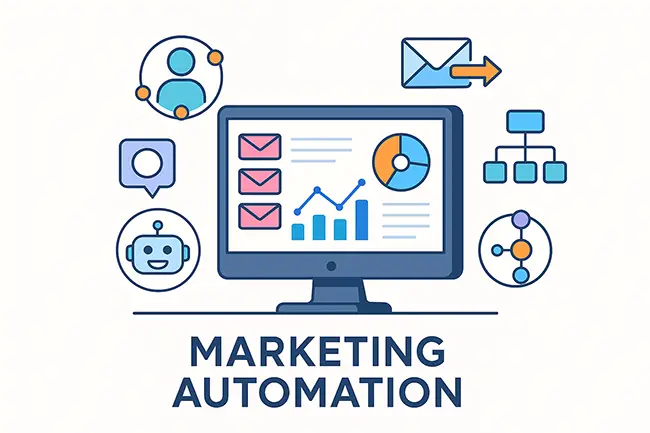La automatización del marketing solía ser el tipo de tecnología que sólo las grandes empresas podían permitirse: plataformas masivas todo en uno que requerían conocimientos de alto nivel, largos periodos de incorporación y presupuestos considerables. Pero esa era ha quedado atrás. Hoy en día, la automatización ha pasado de la torre empresarial al conjunto de herramientas de la pequeña empresa, haciéndose más accesible, asequible y modular.
En esencia, la automatización del marketing es el uso de software para ejecutar y agilizar tareas de marketing repetitivas: envío de correos electrónicos, seguimiento de clientes potenciales, segmentación de listas de clientes y medición del rendimiento de las campañas. La idea es sencilla: ahorrar tiempo, eliminar las conjeturas y ofrecer experiencias más oportunas y personalizadas a su público. Pero la forma en que las empresas lo consiguen ha cambiado radicalmente.
Durante años, el panorama de la automatización estuvo dominado por plataformas como HubSpot, Marketo (ahora propiedad de Adobe) y Pardot de Salesforce. Estos sistemas estaban diseñados para hacerlo todo: marketing por correo electrónico, CRM, puntuación de clientes potenciales, creación de páginas de destino, análisis y mucho más. Eran potentes, y siguen siéndolo, pero su complejidad y coste los hacían inaccesibles para muchas organizaciones pequeñas. Al principio, adoptar la automatización del marketing significaba comprometerse a pagar cuotas mensuales elevadas, a menudo de cientos o miles de dólares, y dedicar muchos recursos internos a la configuración y el mantenimiento.
Pero ese ya no es el único camino.
A medida que la competencia y la demanda han crecido, la automatización del marketing ha empezado a fragmentarse, y eso es bueno. En lugar de depender de una única plataforma para hacerlo todo, las empresas ahora pueden montar su propia pila de automatización a partir de herramientas creadas específicamente. Los servicios de marketing por correo electrónico como Mailchimp, MailerLite y ConvertKit han introducido funciones de automatización avanzadas que antes se consideraban exclusivas de las plataformas empresariales: activadores de comportamiento, flujos condicionales y personalización en tiempo real. Plataformas de CRM como Zoho, Pipedrive e incluso herramientas más sencillas como Streak (que funciona dentro de Gmail) ofrecen seguimientos automatizados, recordatorios de tareas y seguimiento de acuerdos.
Incluso las bases de datos y las plataformas de datos de clientes, que antes eran dominio de los equipos de datos, ahora incluyen capas de automatización. Herramientas como Segment, Klaviyo y Braze permiten a los profesionales del marketing crear flujos de trabajo ricos y basados en eventos en función de cómo interactúan los usuarios con un sitio web o una aplicación, sin necesidad de código. Las plataformas de comercio electrónico como Shopify facilitan la automatización de todo, desde los correos electrónicos de abandono de carritos hasta los mensajes de los programas de fidelización.
Una de las tendencias más importantes que acompañan a este cambio es la caída de los precios. Muchas plataformas ofrecen planes gratuitos o de bajo coste con un generoso conjunto de funciones, lo que permite a los equipos pequeños iniciarse en la automatización por tan sólo $10 a $50 al mes. Los precios se escalan a medida que se crece, pero la barrera de entrada es más baja que nunca. Ya no es necesario pagar tarifas de empresa para obtener resultados de nivel empresarial.
Lo que está surgiendo es un modelo más flexible, en el que la automatización del marketing se configura en función de las necesidades reales de la empresa. No es necesario renovar toda la pila tecnológica para empezar. Puede empezar con el correo electrónico, añadir la automatización a su CRM más adelante y ampliarla a las redes sociales, los SMS o las campañas de retargeting a medida que el recorrido del cliente se vuelve más sofisticado.
Este enfoque modular tiene sus ventajas. Permite a las empresas mantenerse ágiles, probar nuevas herramientas sin grandes compromisos y construir sistemas que evolucionen con ellas. También significa que la automatización ya no se limita a los conocimientos técnicos. Muchas plataformas ofrecen ahora constructores intuitivos de arrastrar y soltar, flujos de trabajo visuales y entornos de pruebas en tiempo real que hacen que crear campañas complejas sea tan sencillo como dibujar un diagrama de flujo.
En resumen, la automatización del marketing ha pasado de ser un producto centralizado a una capacidad distribuida. Ya no se trata de comprar una gran herramienta, sino de reunir las piezas adecuadas que se adapten a sus objetivos, su equipo y su presupuesto.
Para llevar
La automatización del marketing ha madurado hasta convertirse en algo más dinámico y democrático. No es sólo para los profesionales del marketing con grandes equipos o clientes empresariales, sino para cualquiera que desee ahorrar tiempo, escalar de forma más inteligente y ofrecer experiencias más relevantes. Las herramientas de automatización están a su alcance, ya sea fundador de una startup, director de una organización sin ánimo de lucro o propietario de un negocio local. Y cada día son mejores.

